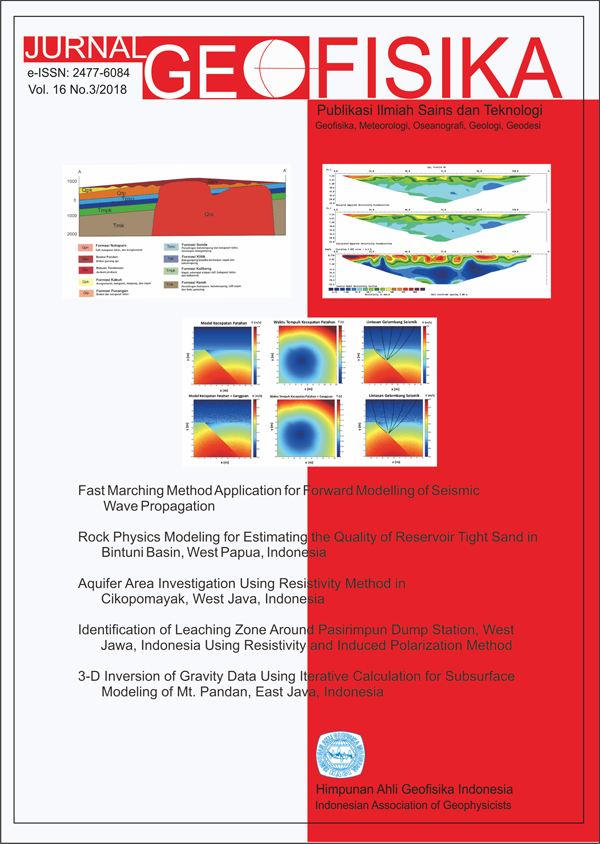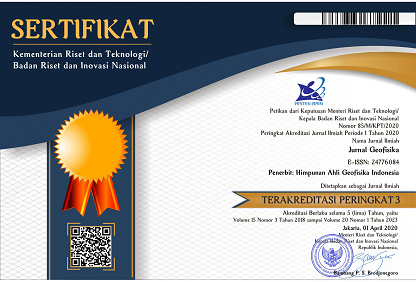Identification of Leaching Zone in Pasirimpun Dump Station, West Java, Indonesia Using Resistivity and Induced Polarization Method
Abstract
The presence of dump stations around resident's houses besides resulting air pollution, it is also affecting
the cleanliness of water used by society to meet their daily needs. Location where we researched is at ex-Pasirimpun Dump Station, Karang Pamulang Village, Kecamatan Cicadas, Bandung. Although Pasirimpun Dump Station has been closed and turned function into Taman Abdi Negara, it is feared that there is a water pollution caused by leach zone. Geophysical measurements by geoelectric method are performed to prove the leaching zone. This study aims to determine the depth of the leaching zone, its position against the groundwater level, and what potential harm can caused by the leaching zone. The methodology that is used are direct observation, interviews, and literature studies. Our measurements is done by using schlumberger conguration and Induced Polarization (IP) method on morphology that tend to be at with a length of 141 meters stretch and a space
of 3 meters. Groundwater faces are mapped to be correlated with the depth of the existing leaching zone. From the results of literature studies, there is a leaching zone in the area with a depth of about 30 meters. By knowing this leaching zone, we hope that there will be cooperation between government and society to avoid
the impacts of leaching zone on the water which they consumed. One way to know, is to drill deeper water level from the leach zone.
References
case studies in Penang, Malaysia. Environmental Earth Sciences.
Breede K, Kemna A (2012) Spectral induced polarization measurements on variably saturated sand-clay mix-
tures. Near Surf Geophys 10(6):479{489. doi:10.3997/1873-0604.2012048
Dahlin T, Rosqvist H, Leroux V (2010) Resistivity-IP for landfill applications. First Break 28(8):101{105 (id:
2344519)
Gallas JDF, Taioli F, Malagutti Filho W (2011) Induced polarization, resistivity, and self-potential: a case history of
contamination evaluation due to landfill leakage. Environ Earth Sci 63(2):251{261. doi:10.1007/s12665-010-0696-y
Gazoty A, Fiandaca G, Pedersen J, Auken E, Christiansen A, Pedersen J (2012b) Application of time-domain induced polarization to the mapping of lithotypes in a landfill site. Hydrol Earth Syst Sci 16(6):1793{1804. doi:10.5194/hess-16-1793-2012
Guerin R, Munoz ML, Aran C, Laperrelle C, Hidra M, Drouart E, Grellier S (2004) Leachate recirculation: moisture content assessment by means of a geophysical technique. Waste Manage 24(8):785{794. doi:10.1016/j.wasman.2004.03.010
Iskandarsyah T. Yan W. M. (2007). Peran batuan dasar TPA dalam mereduksi penyebaran air lindian sampah (leachate) secara alamiah di daerah bekas TPA Pasirimpun. UNPAD
Kaya MA, Ozurlan G, S engul E (2007) Delineation of soil and groundwater contamination using geophysical methods at a waste disposal site in C anakkale, Turkey. Environ Monit Assess 135(1{3):441{446. doi:10.1007/s10661-007-9662-x
Leroux V, Dahlin T, Svensson M (2007) Dense resistivity and induced polarization profiling for a landfill restoration project at Harlov. Southern Sweden. Waste Manage Res 25(1):49{60. doi:10.1177/0734242X07073668
Slater L, Ntarlagiannis D, Wishart D (2006) On the relationship between induced polarization and surface
area in metal-sand and clay-sand mixtures. Geophysics 71(2):A1{A5. doi:10.1190/1. 2187707

This work is licensed under a Creative Commons Attribution 4.0 International License.
The copyright of all articles belongs to the authors. All other copyrights is held by the Journal











